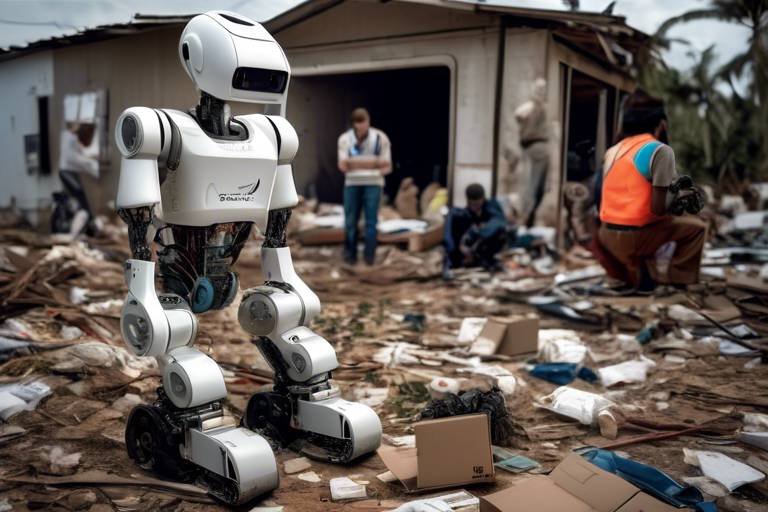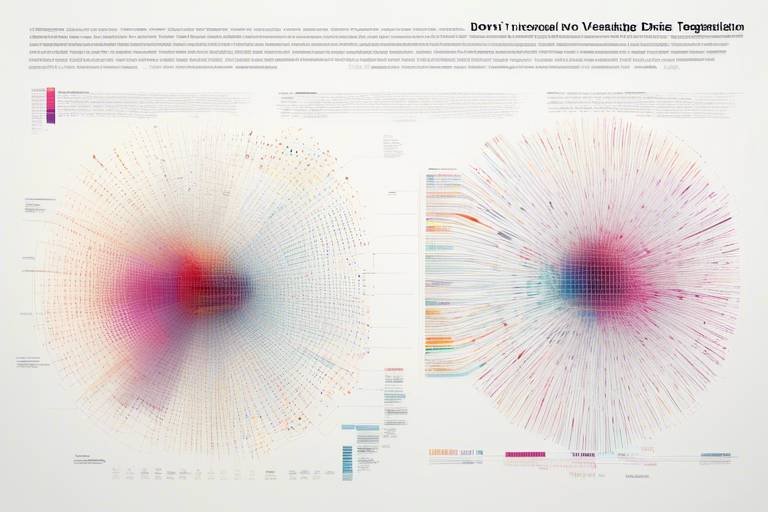How Technology is Influencing Fashion Trends
In today's fast-paced world, the intersection of technology and fashion is more pronounced than ever. Gone are the days when fashion was solely about aesthetics; now, it’s a dynamic blend of innovation, creativity, and practicality. Technology is not just a tool for designers; it’s a catalyst that shapes the very fabric of the industry. From the rise of wearable tech to the implementation of sustainable practices, technology is redefining how we perceive and engage with fashion. Imagine walking down the street and seeing a smart jacket that adjusts its temperature based on the weather, or a pair of shoes that tracks your steps while looking chic. This is not science fiction; this is the new reality of fashion.
Wearable technology has truly transformed the fashion landscape, integrating functionality with style. Think about it: smartwatches, fitness trackers, and even smart fabrics are not just accessories; they are essential parts of our daily lives. Consumers are increasingly drawn to items that offer both aesthetic appeal and practical benefits. For instance, a stylish smartwatch can keep you connected while complementing your outfit. Designers are now challenged to create apparel that accommodates these tech innovations, leading to a new era of tech-friendly fashion.
As the world becomes more conscious of its environmental footprint, technology is paving the way for sustainable fashion practices. Innovations in materials and production methods are enabling designers to create eco-friendly garments without sacrificing style. For example, the use of recycled materials and organic fabrics is on the rise, allowing brands to cater to eco-conscious consumers. This shift not only reduces waste but also promotes ethical fashion choices. A significant factor in this movement is the ability of technology to track and reduce the environmental impact of fashion production.
One of the most exciting advancements in the fashion industry is 3D printing. This technology is revolutionizing garment production by allowing for unprecedented levels of customization while simultaneously reducing material waste. Imagine being able to design your own dress and have it printed in a matter of hours! Designers are now experimenting with new forms and structures, pushing the boundaries of traditional fashion design. The possibilities are endless, and this innovation is reshaping the way we think about clothing.
With 3D printing, consumers can personalize their fashion items, leading to a unique shopping experience. This trend is not just about owning a one-of-a-kind piece; it’s about expressing individuality. Consumers can choose colors, materials, and even styles that resonate with their personal tastes. This level of customization is driving brands to offer tailored solutions, making shopping more interactive and engaging.
Moreover, 3D printing technology is streamlining supply chains by significantly reducing production times and costs. This efficiency is crucial for brands aiming to respond quickly to changing fashion trends. Instead of waiting weeks for a shipment from overseas, brands can produce items on-demand, which not only saves time but also minimizes excess inventory. This shift not only benefits the brands but also the consumers who can enjoy the latest trends without the long wait.
In recent years, virtual fashion shows have emerged as a new norm, allowing designers to reach global audiences without the limitations of physical venues. This shift is changing how brands showcase their collections and engage with consumers. Imagine being able to attend a fashion show from the comfort of your own home, complete with interactive elements that allow you to explore the designs up close. Virtual fashion shows are breaking down geographical barriers, making fashion more accessible than ever before.
In the digital age, social media platforms have become powerful tools for fashion marketing, shaping trends and influencing consumer preferences. Influencers and online communities play a significant role in this landscape, often dictating what’s in vogue and what’s not. With just a few clicks, a new trend can go viral, reaching millions of potential customers. This phenomenon has transformed the way brands approach marketing, making it essential to engage with consumers through social media channels.
Influencer marketing leverages social media personalities to promote fashion brands. This strategy is highly effective in reaching target demographics and creating authentic connections with consumers. An influencer’s endorsement can elevate a brand’s visibility, making it crucial for companies to collaborate with the right personalities. The impact of an influencer can be likened to word-of-mouth marketing on steroids; it’s fast, far-reaching, and incredibly influential.
Another trend reshaping brand narratives is user-generated content. As consumers share their fashion experiences online, they contribute to a more authentic representation of brands. This trend fosters community engagement and influences purchasing decisions in the fashion industry. When potential buyers see real people wearing a brand’s items, it creates a sense of trust and relatability that traditional advertising often lacks.
- How is technology changing the fashion industry? Technology is introducing innovations like wearable tech, 3D printing, and virtual fashion shows, all of which are reshaping how fashion is designed, produced, and marketed.
- What role does social media play in fashion trends? Social media platforms are essential for marketing, allowing brands to reach wider audiences and engage directly with consumers through influencers and user-generated content.
- What are the benefits of sustainable fashion practices? Sustainable practices help reduce waste, promote ethical choices, and cater to eco-conscious consumers, making fashion more responsible and appealing.

Wearable Technology
In recent years, has emerged as a game-changer in the fashion industry, seamlessly blending functionality with style. Imagine strapping on a smartwatch that not only tells time but also tracks your heart rate, monitors your sleep patterns, and even alerts you about your incoming calls and messages. This fusion of technology and fashion is not just about looking good; it’s about enhancing our daily lives. As consumers become more health-conscious and tech-savvy, the demand for stylish yet practical wearables has skyrocketed, leading designers to innovate and rethink traditional fashion norms.
Wearable tech encompasses a variety of devices, including fitness trackers, smart glasses, and even smart clothing. These gadgets are influencing consumer choices significantly. For instance, a sleek fitness tracker can motivate someone to stay active while also serving as a fashionable accessory. This shift in consumer behavior is prompting brands to incorporate tech features into their designs, resulting in a new category of fashion that prioritizes both aesthetics and utility.
Moreover, the integration of wearable technology is also reshaping the way brands market their products. With the rise of social media, influencers are showcasing their favorite wearable gadgets, creating a buzz around the latest trends. This has led to a culture where consumers not only want to wear the latest styles but also want their clothing to tell a story about their lifestyle choices. In fact, a recent survey indicated that over 70% of consumers are more inclined to purchase fashion items that incorporate technology. This statistic highlights a significant shift in the market, where tech-savvy consumers are actively seeking out products that enhance their lives.
As we look ahead, it’s clear that wearable technology is here to stay. The intersection of fashion and tech is only set to grow, with advancements like smart fabrics that can change color based on temperature or mood, and augmented reality applications that allow consumers to try on clothes virtually. This evolution is not just about keeping up with trends; it’s about creating a more personalized and interactive shopping experience. The future of fashion is undoubtedly intertwined with technology, and as consumers, we are all part of this exciting journey.

Sustainable Fashion Innovations
In today's world, where environmental consciousness is on the rise, the fashion industry is undergoing a significant transformation thanks to technology. Sustainable fashion innovations are not just a trend; they're becoming a necessity. With consumers increasingly demanding eco-friendly options, designers and brands are stepping up to the plate, integrating advanced technologies that promote sustainability. But what does this really mean for the industry? How are these innovations reshaping our wardrobes and the planet?
One of the most exciting developments in sustainable fashion is the creation of eco-friendly materials. Innovations like organic cotton, recycled polyester, and even materials made from pineapple leaves (known as Piñatex) are gaining traction. These materials not only help reduce waste but also lessen the environmental impact of traditional textile production. For instance, producing recycled polyester can save up to 90% of the water used in conventional polyester manufacturing. This shift is crucial as the fashion industry is notorious for its heavy resource consumption.
Moreover, technology is enhancing production methods, making them more environmentally friendly. Techniques such as laser cutting and digital printing minimize waste by using precise measurements and reducing excess fabric. This shift towards precision not only conserves resources but also allows designers to experiment with intricate designs that were previously challenging to achieve. Imagine a world where every piece of clothing is crafted with minimal waste—this is the future that technology is helping to create.
Another fascinating aspect of sustainable fashion innovations is the rise of blockchain technology. This technology is being utilized to ensure transparency in the supply chain, allowing consumers to trace the origins of their garments. Knowing where and how their clothes are made empowers consumers to make informed choices, supporting brands that prioritize ethical practices. This transparency can also encourage brands to uphold their sustainability commitments, as they are held accountable by their customers.
Furthermore, the concept of circular fashion is gaining momentum, where the life cycle of a garment is extended through recycling and upcycling. Brands are now designing clothes with the end in mind, ensuring that when a piece is no longer wanted, it can be easily recycled or repurposed. This approach not only reduces waste but also encourages a shift in consumer behavior towards valuing longevity over fast fashion. Imagine if every piece of clothing you bought could be returned to the earth or transformed into something new—this is the promise of circular fashion.
As we delve deeper into these innovations, it's clear that technology is not just a tool; it's a catalyst for change in the fashion industry. By embracing sustainable practices, brands are not only appealing to eco-conscious consumers but also paving the way for a more responsible future. The intersection of fashion and technology is creating an exciting landscape where style meets sustainability, and the possibilities are endless.
- What are some examples of sustainable materials? Eco-friendly materials include organic cotton, recycled polyester, and Piñatex made from pineapple leaves.
- How does technology help reduce waste in fashion? Technologies like laser cutting and digital printing allow for precise measurements, minimizing excess fabric and waste.
- What is circular fashion? Circular fashion focuses on extending the life cycle of garments through recycling and upcycling, promoting sustainability.
- How can consumers ensure their clothing is ethically made? By utilizing blockchain technology, consumers can trace the origins of their garments and support brands that prioritize ethical practices.

3D Printing in Fashion
3D printing is not just a buzzword; it's a revolution in the fashion industry that is changing the way we think about garment production. Imagine being able to create a unique piece of clothing right from your home, tailored to your exact specifications. That's the magic of 3D printing! This technology allows designers to produce intricate designs that were previously impossible or too costly to create using traditional methods. By utilizing computer-aided design (CAD) software, designers can bring their creative visions to life with remarkable precision.
One of the most significant benefits of 3D printing in fashion is its potential to reduce material waste. Traditional garment manufacturing often results in excess fabric scraps and unsold inventory, contributing to environmental issues. In contrast, 3D printing is an additive process, meaning it only uses the materials necessary to create the final product. This not only minimizes waste but also allows for more sustainable practices in the fashion industry.
Furthermore, 3D printing enables a level of customization that consumers have never experienced before. Picture this: you walk into a store, and instead of selecting from a limited range of sizes and styles, you can design your own shoes, dresses, or accessories. This is becoming a reality as brands begin to offer personalized options through 3D printing technology. Consumers can choose colors, patterns, and even specific fits, making each item a unique expression of their personal style.
To illustrate the impact of 3D printing on the fashion industry, consider the following table that highlights key advantages:
| Advantages of 3D Printing in Fashion | Description |
|---|---|
| Reduced Waste | Only the necessary materials are used, minimizing excess fabric and environmental impact. |
| Customization | Consumers can create personalized designs that reflect their individual style. |
| Speed | Production times are significantly shortened, allowing for faster turnaround of new designs. |
| Innovation | Designers can experiment with complex structures and forms that traditional methods can't achieve. |
Another exciting aspect of 3D printing is its potential to streamline supply chains. By enabling on-demand production, brands can drastically cut down on production times and costs. This efficiency is crucial in today’s fast-paced fashion landscape, where trends can change overnight. Instead of producing large quantities of a single design and risking overstock, brands can produce items as they are ordered, ensuring that they meet consumer demand without excess.
As we look to the future, it's clear that 3D printing is not just a passing trend; it's a fundamental shift in how fashion is created and consumed. With its ability to foster creativity, promote sustainability, and enhance consumer engagement, this technology is set to redefine the fashion landscape in ways we are only beginning to understand. So, the next time you slip into a new outfit, think about the journey it took to get there and the exciting innovations that are shaping its future.
- What is 3D printing? - 3D printing is an additive manufacturing process that creates three-dimensional objects by layering materials based on digital models.
- How does 3D printing reduce waste in fashion? - It uses only the materials needed to create an item, minimizing excess fabric and reducing environmental impact.
- Can consumers customize their clothing with 3D printing? - Yes, many brands are beginning to offer personalized designs through 3D printing technology.
- What are the benefits of 3D printing for designers? - Designers can create complex designs, reduce production time, and minimize waste, allowing for greater creativity and efficiency.

Customization and Personalization
In today's fast-paced world, have become more than just buzzwords; they are essential elements that consumers now expect from their fashion experiences. Imagine walking into a store and being able to create a piece of clothing that reflects your unique style, right down to the color, fabric, and fit. This is no longer a distant dream thanks to advancements in technology, particularly through the revolutionary capabilities of 3D printing.
With 3D printing technology, the fashion industry is witnessing a paradigm shift. Designers can now produce garments that are not only tailored to individual preferences but also reduce waste significantly. Instead of mass-producing items that may or may not sell, brands can create on-demand pieces that cater specifically to the tastes of their customers. This shift is akin to moving from a one-size-fits-all approach to a bespoke tailoring service, where every stitch is crafted with the wearer in mind.
Furthermore, the rise of online platforms has made it easier than ever for consumers to engage in the design process. For instance, brands are offering online customization tools that allow shoppers to select various elements of a garment before it is made. This could include:
- Choosing the fabric type
- Selecting colors and patterns
- Adding personal monograms or designs
Such options not only enhance the shopping experience but also cultivate a deeper emotional connection between the consumer and the product. When someone wears a piece of clothing that they helped design, it becomes more than just an item; it transforms into a personal statement and a reflection of their identity.
Additionally, brands are leveraging data analytics to understand consumer preferences better. By analyzing purchasing patterns and feedback, they can offer tailored recommendations that resonate with individual customers. This level of personalization is not just a trend; it's becoming a standard expectation. Consumers want to feel special, and brands that can deliver on this front are likely to cultivate loyalty and repeat business.
The implications of this trend extend beyond just consumer satisfaction. Brands that embrace customization can also differentiate themselves in a crowded marketplace. In an era where consumers are bombarded with choices, offering a unique, personalized product can be the key to standing out. This strategy is akin to a chef crafting a signature dish that keeps diners coming back for more, ensuring that the brand remains top-of-mind.
As we look to the future, it’s clear that customization and personalization will continue to play a pivotal role in the fashion industry. The integration of technology, such as augmented reality (AR) and virtual fitting rooms, will further enhance the ability for consumers to visualize their custom designs before making a purchase. This not only reduces the likelihood of returns but also enhances customer satisfaction. The fashion landscape is evolving, and those who embrace these changes will be at the forefront of this exciting journey.
1. What is customization in fashion?
Customization in fashion refers to the process where consumers can modify or personalize clothing and accessories to meet their individual preferences, such as choosing colors, fabrics, and styles.
2. How does 3D printing contribute to personalization?
3D printing allows designers to create unique garments on-demand, reducing waste and enabling consumers to have clothing tailored specifically to their tastes and measurements.
3. Why is personalization important in today's fashion industry?
Personalization is crucial as it helps brands connect with consumers on a deeper level, fostering loyalty and enhancing the overall shopping experience by making customers feel valued and unique.
4. What technologies are enhancing customization?
Technologies such as augmented reality (AR), online customization tools, and data analytics are enhancing customization by allowing consumers to visualize their designs and brands to understand consumer preferences better.

Impact on Supply Chains
The advent of 3D printing technology has had a profound impact on supply chains in the fashion industry. Traditionally, the fashion supply chain involved multiple stages, from design and production to distribution and retail. However, with the integration of 3D printing, this process has become significantly more streamlined. Imagine being able to produce garments on-demand, reducing the need for large inventories and minimizing the risk of unsold stock. This not only saves costs but also aligns perfectly with the growing demand for sustainability in fashion.
One of the most exciting aspects of this technology is its ability to drastically reduce production times. In the past, creating a prototype or sample of a new design could take weeks or even months. With 3D printing, designers can produce samples in a matter of hours. This rapid prototyping allows brands to test new designs quickly, gather feedback, and make necessary adjustments before launching a full production run. It’s like having a magic wand that transforms ideas into tangible products in the blink of an eye!
Moreover, 3D printing enables a significant reduction in material waste. Traditional manufacturing processes often result in a large amount of leftover fabric and materials, contributing to the environmental crisis. In contrast, 3D printing uses only the materials needed for the final product, which can lead to a more sustainable approach. Brands can now create intricate designs without the fear of excess waste, making it a win-win situation for both the environment and the bottom line.
Additionally, the flexibility of 3D printing technology allows brands to respond quickly to changing fashion trends. For instance, if a particular style gains popularity overnight, brands can rapidly produce items that reflect this trend without the lengthy lead times associated with traditional manufacturing. This agility is crucial in today’s fast-paced fashion landscape, where consumer preferences can shift almost instantaneously.
In conclusion, the impact of 3D printing on supply chains is nothing short of revolutionary. It not only enhances efficiency and reduces costs but also promotes sustainability and responsiveness to market demands. As this technology continues to evolve, we can expect to see even more innovative applications that will reshape the future of fashion production.
- What is 3D printing in fashion? 3D printing in fashion refers to the use of additive manufacturing technology to create clothing, accessories, and footwear directly from digital designs.
- How does 3D printing reduce waste in fashion? 3D printing minimizes waste by using only the necessary materials for production, unlike traditional methods that often result in leftover fabric and materials.
- Can 3D printing be used for mass production? While 3D printing is excellent for customization and small batches, advancements are being made to scale it for larger production runs.
- How does 3D printing affect fashion trends? 3D printing allows brands to quickly adapt to emerging trends by rapidly prototyping and producing new designs.

Virtual Fashion Shows
In recent years, have emerged as a groundbreaking trend in the fashion industry, reshaping the way designers present their collections. Gone are the days when fashion shows were exclusive events held in lavish venues, accessible only to a select few. Now, with the power of technology, brands can reach a global audience with just a click of a button. Imagine sitting in your living room, sipping coffee, while watching the latest runway looks from Paris, New York, or Milan unfold right before your eyes!
This shift to virtual platforms has opened up a world of possibilities for both designers and consumers. Not only does it democratize fashion, making it available to everyone, but it also allows for a more interactive experience. Viewers can engage with the content in real-time, share their thoughts on social media, and even purchase items directly from the runway. It's like having a front-row seat to a show where you can also participate in the conversation!
One of the most exciting aspects of virtual fashion shows is the creativity and innovation they allow. Designers are no longer confined to physical limitations; they can experiment with stunning visuals, animations, and digital effects that enhance the storytelling of their collections. For instance, a fashion show could feature models walking through a virtual forest or strutting down a futuristic cityscape, creating an immersive experience that captures the audience's imagination.
Moreover, these virtual events are often more sustainable compared to traditional shows. They reduce the carbon footprint associated with travel, venue setup, and waste generated from physical events. In a world increasingly focused on sustainability, this is a significant advantage that aligns with the values of modern consumers who are more environmentally conscious.
However, while virtual fashion shows have their perks, they also present unique challenges. Designers must find ways to ensure their collections resonate with viewers who are accustomed to the high-energy atmosphere of live shows. This requires a blend of artistic vision and technical prowess. The use of advanced technologies such as augmented reality (AR) and virtual reality (VR) is becoming more common, allowing consumers to engage with fashion in ways that were previously unimaginable.
As we look to the future, it’s clear that virtual fashion shows are here to stay. They are not just a temporary solution to the challenges posed by global events, but rather a new chapter in the fashion narrative. Brands that embrace this trend will likely find themselves at the forefront of innovation, capturing the attention of a digitally-savvy audience eager for fresh experiences.
- What are virtual fashion shows? Virtual fashion shows are online events where designers showcase their collections to a global audience through digital platforms.
- How do virtual fashion shows benefit brands? They increase accessibility, reduce costs, and allow for innovative presentations that can reach a wider audience.
- Can consumers purchase items directly from virtual fashion shows? Yes, many brands offer direct purchasing options during or after the show, making it easy for viewers to shop the looks they love.
- Are virtual fashion shows more sustainable? Yes, they typically have a lower environmental impact compared to traditional fashion shows, as they reduce travel and waste.

Social Media Influences
In today's digital age, social media has become a powerful catalyst for shaping fashion trends and consumer preferences. Platforms like Instagram, TikTok, and Pinterest are not just places to share photos; they are vibrant communities where fashion enthusiasts converge to discover, discuss, and influence what’s hot and what’s not. Have you ever noticed how quickly a new style can go viral? That's the magic of social media at work! These platforms allow trends to spread like wildfire, reaching audiences far beyond traditional fashion shows or magazines.
One of the most significant impacts of social media on fashion is through influencer marketing. Influencers are often seen as trendsetters, and their recommendations can sway purchasing decisions dramatically. When a popular influencer shares a post wearing a particular outfit, it can lead to an immediate spike in demand for those items. This phenomenon has led brands to collaborate with influencers to maximize their reach. It’s almost like having a personal shopper who’s always in style, guiding you on what to wear. The authenticity that influencers bring to their endorsements creates a sense of trust among their followers, making them more likely to try out the products they promote.
Moreover, the rise of user-generated content has further transformed the fashion landscape. This trend allows consumers to become active participants in the fashion narrative, sharing their own style choices and experiences online. When everyday individuals post photos of themselves wearing a brand, it creates a sense of community and relatability that traditional advertising often lacks. Brands are now encouraged to engage with their customers directly, responding to comments and sharing user-generated content on their own platforms. This interaction not only fosters loyalty but also influences purchasing decisions, as potential buyers see real people enjoying the products.
Social media also facilitates a two-way communication channel between brands and consumers, allowing for immediate feedback. Brands can gauge consumer reactions to new collections almost instantly, making it easier to adapt to changing trends. For instance, if a particular style is trending based on user feedback, brands can quickly pivot their marketing strategies or even adjust their product offerings to align with consumer desires. This adaptability is crucial in the fast-paced fashion industry, where today’s trend can become tomorrow’s faux pas.
To illustrate the impact of social media on fashion trends, consider the following table that highlights some key statistics:
| Statistic | Impact on Fashion |
|---|---|
| 70% of consumers are influenced by social media when making fashion purchases | Brands must prioritize their online presence to capture consumer interest. |
| Over 50% of Gen Z shoppers prefer to discover new brands on social media | Brands targeting younger demographics need to focus on platforms like TikTok and Instagram. |
| Influencer marketing can yield an ROI of $5.78 for every dollar spent | Investing in influencer partnerships can be highly lucrative for brands. |
In conclusion, social media has not only reshaped how we perceive fashion but has also revolutionized how brands market their products. The ability to connect with consumers on a personal level, coupled with the rapid dissemination of trends, has created a dynamic environment where fashion is more accessible and interactive than ever before. As we continue to navigate this digital landscape, one thing is clear: the influence of social media on fashion is here to stay, and it’s only going to grow stronger.
- How do influencers affect fashion trends? Influencers can significantly sway consumer behavior by showcasing products to their followers, creating a sense of trust and authenticity.
- What role does user-generated content play in fashion? User-generated content allows consumers to share their experiences with brands, fostering community engagement and influencing others' purchasing decisions.
- How can brands effectively use social media? Brands can leverage social media by collaborating with influencers, engaging with their audience, and adapting to consumer feedback quickly.

Influencer Marketing
Influencer marketing has emerged as a powerful force in the fashion industry, acting as a bridge between brands and consumers. In today’s digital age, where social media reigns supreme, the influence of online personalities cannot be overstated. These influencers, whether they’re fashion bloggers, Instagram stars, or YouTube sensations, have cultivated dedicated followings that trust their opinions and style choices. This trust is a goldmine for fashion brands looking to connect authentically with their target demographics. By collaborating with these influencers, brands can tap into their vast networks and reach potential customers in a more personal and engaging way.
One of the most compelling aspects of influencer marketing is its ability to create a sense of community among consumers. When influencers share their personal fashion journeys, they invite their followers into their lives, creating a bond that traditional advertising simply cannot achieve. This connection fosters loyalty and encourages followers to emulate their style, leading to an increase in brand visibility and sales. According to a recent study, **over 70% of millennials** are influenced by the recommendations of their peers and social media personalities when making purchasing decisions. This statistic underscores the importance of influencer marketing in shaping consumer behavior in the fashion industry.
Moreover, influencer marketing allows for a diverse range of voices and styles to be represented in the fashion narrative. Unlike conventional advertising, which often features a narrow depiction of beauty and style, influencers come in all shapes, sizes, and backgrounds. This inclusivity resonates with consumers who are increasingly seeking authenticity and representation in the brands they support. As a result, fashion brands that embrace influencer partnerships often find themselves at the forefront of cultural conversations, appealing to a broader audience and driving engagement.
However, it’s essential for brands to choose their influencers wisely. Not every influencer will align with a brand’s values or target audience. Conducting thorough research and ensuring that there is a genuine connection between the influencer and the brand is crucial. Brands should consider factors such as the influencer's engagement rates, audience demographics, and previous collaborations before entering into partnerships. This strategic approach not only maximizes the effectiveness of the campaign but also maintains the integrity of the brand.
In conclusion, influencer marketing is revolutionizing the way fashion brands connect with consumers. By leveraging the power of social media personalities, brands can create authentic relationships, foster community engagement, and ultimately drive sales. As the fashion landscape continues to evolve, it’s clear that influencer marketing will remain a key player in shaping trends and consumer preferences.
- What is influencer marketing?
Influencer marketing involves collaborating with social media personalities to promote products or services, leveraging their reach and credibility to connect with target audiences. - How does influencer marketing benefit fashion brands?
It enhances brand visibility, fosters community engagement, and builds trust with consumers, leading to increased sales and loyalty. - What should brands consider when choosing influencers?
Brands should assess alignment with their values, audience demographics, engagement rates, and past collaborations to ensure a successful partnership.

User-Generated Content
In today's digital landscape, user-generated content (UGC) has emerged as a powerful force in the fashion industry. This phenomenon refers to any content—such as images, videos, or reviews—created by consumers rather than brands. Imagine scrolling through your social media feed and coming across a stunning outfit worn by a friend or an influencer. That image not only captures your attention but also influences your buying decisions. UGC is reshaping how brands communicate with their audiences, fostering a sense of community and authenticity that traditional advertising often lacks.
One of the most exciting aspects of UGC is its ability to create genuine connections between consumers and brands. When people share their fashion experiences online, they contribute to a larger narrative that resonates with others. This shared experience cultivates trust, as potential buyers are more likely to relate to real-life stories than polished marketing campaigns. Brands that embrace UGC can tap into this authenticity, showcasing their products in real-world scenarios and highlighting how their items fit into everyday life.
Furthermore, UGC serves as a valuable resource for brands looking to enhance their marketing strategies. By analyzing the content generated by users, companies can gain insights into consumer preferences and trends. This data can inform design decisions, marketing campaigns, and even inventory management. For instance, if a particular style or color is frequently featured in user posts, brands can adjust their offerings to meet this demand. In this way, UGC not only influences consumer behavior but also drives business decisions.
To illustrate the impact of user-generated content, let's take a look at a few statistics that highlight its effectiveness:
| Statistic | Impact |
|---|---|
| 79% of people say user-generated content highly impacts their purchasing decisions. | This shows the significant influence of UGC on consumer behavior. |
| Consumers are 2.4 times more likely to view user-generated content as authentic compared to brand-created content. | Authenticity is key in building trust and loyalty among consumers. |
| UGC can lead to a 20% increase in return visitors to a brand's website. | Engagement through UGC can drive traffic and boost brand visibility. |
In conclusion, user-generated content is not just a passing trend; it is a fundamental shift in how fashion brands engage with their audience. By leveraging UGC, brands can create a more interactive and responsive shopping experience. As consumers increasingly seek authenticity and community, the importance of UGC will only continue to grow in the fashion industry. So, the next time you share a photo of your favorite outfit online, remember that you’re not just showcasing your style; you’re also contributing to a vibrant fashion dialogue that can influence trends and inspire others.
- What is user-generated content in fashion?
User-generated content refers to any content created by consumers, such as photos, reviews, or videos, that showcases their experiences with fashion brands. - How does UGC influence purchasing decisions?
UGC builds trust and authenticity, making consumers more likely to purchase products that they see others using and enjoying. - Can brands benefit from user-generated content?
Absolutely! Brands can use UGC to gain insights into consumer preferences, improve marketing strategies, and create a sense of community around their products.
Frequently Asked Questions
- How is wearable technology changing the fashion industry?
Wearable technology is merging functionality with style, significantly impacting consumer choices. From smartwatches to fitness trackers, these gadgets are not just practical but also serve as fashion statements. Designers are now challenged to create tech-friendly apparel that meets the demands of tech-savvy consumers while maintaining aesthetic appeal.
- What role does technology play in promoting sustainable fashion?
Technology is crucial in advancing sustainable fashion practices. Innovations such as eco-friendly materials and efficient production methods are helping brands reduce waste and promote ethical choices. By leveraging technology, the fashion industry can minimize its environmental footprint while appealing to conscious consumers.
- How does 3D printing benefit the fashion industry?
3D printing is revolutionizing garment production by allowing for high levels of customization and significantly reducing material waste. This technology not only enables designers to experiment with unique forms and structures but also enhances the consumer experience by offering personalized fashion items.
- What impact does 3D printing have on supply chains?
3D printing streamlines supply chains by cutting down production times and costs. This efficiency is vital for brands that need to respond swiftly to ever-changing fashion trends, ultimately leading to a more agile and responsive industry.
- Why are virtual fashion shows gaining popularity?
Virtual fashion shows have become a new norm, allowing designers to showcase their collections to a global audience without the constraints of physical venues. This shift not only broadens reach but also transforms how brands engage with consumers, making fashion more accessible than ever.
- How do social media platforms influence fashion trends?
Social media platforms are powerful tools for fashion marketing, shaping trends and consumer preferences. Influencers and online communities play a significant role in driving fashion choices, creating a ripple effect that can propel certain styles into the mainstream.
- What is influencer marketing in the fashion industry?
Influencer marketing leverages the popularity of social media personalities to promote fashion brands. This strategy effectively reaches target demographics and fosters authentic connections with consumers, making it a vital component of modern fashion marketing.
- How does user-generated content affect fashion brands?
User-generated content reshapes brand narratives by allowing consumers to share their fashion experiences online. This trend enhances community engagement and significantly influences purchasing decisions, as potential buyers often trust peer recommendations over traditional advertising.



















